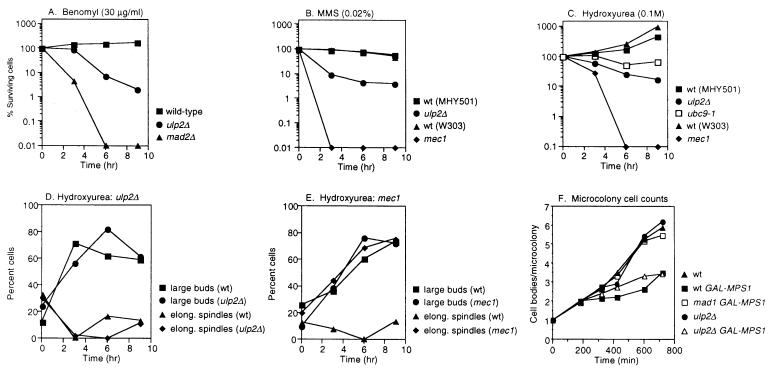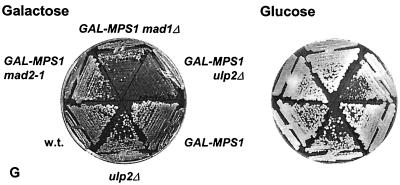FIG. 6.
Evaluation of checkpoint function in the ulp2Δ mutant. (A) Growth of cells after incubation for the indicated times in benomyl. The treated cells were spread on YPD plates and incubated at 30°C. Survival was calculated as the percentage of colonies formed from each time point sample relative to the number counted at the outset of the treatment for each strain. The strains used were MHY501, MHY1380, and MHY1628. (B) Growth of cells after incubation in MMS. The ulp2Δ and ubc9-1 mutants are congenic with MHY501, and the mec1 mutant MHY1621 is congenic with W303a. wt, wild type. (C) Growth of cells after incubation in hydroxyurea. (D) Normal block to spindle elongation in ulp2Δ cells exposed to 0.1 M hydroxyurea. Cell budding and spindles were evaluated from micrographs of anti-tubulin-stained cells. The mean numbers of cells counted for each time point were 51 and 68 for MHY501 (wild type) and MHY1380 (ulp2Δ), respectively. (E) Abnormal spindle elongation in the mec1 checkpoint mutant evaluated as for panel D. The mean numbers of cells counted for each time point were 56 and 44 for W303a (wild type) and MHY1621 (mec1), respectively. (F) Average number of cell bodies (cells plus buds) observed in microcolonies that initiated from single cells of the indicated genotype, which were isolated from an α-factor synchronized cell population. Strains were isogenic except as indicated (11). Plates contained 2% galactose. (G) Inhibition of colony formation of ulp2Δ cells overexpressing MPS1.


